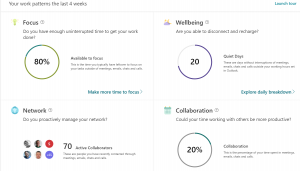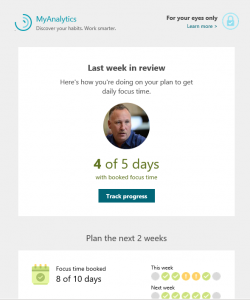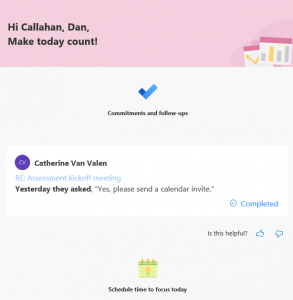You have no doubt heard the phrase “work smarter, not harder”. (This can be especially annoying if the phrase was uttered by someone immediately after assigning you one of their tasks. I suppose this was their method of “working smarter”.) “Okay,” you say, “but how? How do I ‘work smarter’”? Microsoft thinks it has an answer. They want you to work smarter with MyAnalytics.
Before I get into the details of how you can work smarter with MyAnalytics, allow me to note that MyAnalytics is one of a group of applications that is controversial for three reasons.
- MyAnalytics interacts directly with end users. It is available to virtually all end users and is enabled by default.
- While there are some administrative controls applicable to MyAnalytics, there is no simple way to turn it off and keep it off for all users.
- Some users find the insights that MyAnalytics provides to be useful. Other users think it is sort of creepy that MyAnalytics seems to know so much about them.
What is MyAnalytics?
MyAnalytics aims to help users be more productive by offering tips on collaboration and setting aside time to focus on a task. MyAnalytics also offers suggestions for creating a better work life balance, managing your network of contacts, and refining your work habits.
These MyAnalytics suggestions are driven from data collected from your calendar and email. For instance, MyAnalytics tracks whether you spend time reading and responding to email while you are in a meeting. Yeah, I do not want to hear about your multitasking.
MyAnalytics provides a dashboard that the user can see, summarizing their work habits and goals. Here is an example.

MyAnalytics will also send you messages via Outlook that suggest tasks to create based on the content of your email. For instance, if you write that you will schedule a meeting in the next few days, MyAnalytics will send an email asking if you want to add that task to your task list.
MyAnalytics will also send you a weekly digest that highlights how much “Focus Time” you scheduled for the past week, as well as how much time you spent in meetings. Here are two examples.


Is MyAnalytics Useful?
Have you ever felt like you were at the mercy of your calendar? Have you felt at times that keeping up with all the urgent stuff was crowding out your ability to address the important stuff? Do you struggle to keep up with the commitments that you make via email? If any of these situations resonates with you, then you might want to give MyAnalytics a try.
MyAnalytics Can Help You Focus
I learned long ago that things do not happen unless I reserve time for them on my calendar. For instance, I have set aside a block of time each week to write these blog posts. MyAnalytics gives me a way to do this automatically by creating blocks of time that it calls “Focus Time”. It looks for two-hour open blocks on my calendar and asks me if I would like to schedule Focus Time for one of those blocks. I can do this in an ad hoc fashion. Or I can create a “Focus Plan” that allows me to pick how much Focus Time I want to schedule each day, what time of day I want to schedule that time, and whether I want to block Teams notifications during Focus Time.
I like to think of Focus Time as the virtual version of the ”Do Not Disturb” hotel card that I used to hang on my office door.
Want Help with Task Management?
I go through the day making lots of commitments. Sometimes I make these verbally, sometimes I make them via email, sometimes I just want to remember to go back and read something or respond more thoughtfully to a message. I can use different task management tools to record and manage these tasks. But I like the ability to have MyAnalytics find these commitments via email messages and ask me if I want to record them as a task. This saves me the step of exiting email, switching over to my task management application, and noting the task.
Get Prepared for Your Meetings
The one other way that I find MyAnalytics useful is in meeting preparation. MyAnalytics will find a meeting on my calendar and find what it believes to be associated emails and documents. It will then send me an email with this information, offering me the opportunity to review materials before the meeting. If you find yourself in a lot of meetings, and especially if you find yourself scrambling to locate the relevant documents associated with your meetings, I think you will find this feature useful.
How Can I Control the MyAnalytics Experience?
As a User
As a user if you like MyAnalytics there is very little that you need to do. You can access MyAnalytics from the app launcher within Microsoft 365. Probably the easiest way to get MyAnalytics is to add the “My Insights” app into your Outlook client. Soon you will be receiving emails from Cortana, MyAnalytics, or My Insights offering suggestions for how to make your workday more productive.
But maybe you do not like the idea have some Mechanical Turk telling you how many emails you read while you were in a meeting. Or perhaps you have already worked out your preferred methods for being productive. In this case you can opt out of the MyAnalytics experience. Just go to your MyAnalytics dashboard. From there you can opt out of some or all elements of the service.
As an Admin
If you are an admin wanting to control the MyAnalytics experience for your entire organization, you have some choices, although they may not be permanent.
- First, you can in theory remove the license that includes MyAnalytics from a user’s account. However, MyAnalytics is included in just about every Office 365 or Microsoft 365 subscription. So, this is not a practical solution for you.
- You can configure MyAnalytics at the tenant level and opt users out individually or in blocks. You can also control the MyAnalytics elements that users can access. This includes the Insights dashboard, the Weekly Digest, and the Insights Outlook add-in. However, users can still opt back in to any of these settings.
Maybe this is not so bad. Some customers have told me they are concerned that exposing users to MyAnalytics will lead to confusion and complaints. I would suppose that if a user opts back in to MyAnalytics, then they must see some value in the feature.
I should also point out that Microsoft does not share a user’s data with anyone else for privacy reasons. So, if you have a user who is concerned about what MyAnalytics knows about their work habits, you can assure them that the information is private.
Give MyAnalytics a Try
Maybe it is because I am a data geek. But I like it when my insights tells me that I only responded to 24% of emails while I was in a scheduled Focus Time session. If you are also a person that likes to change your work habits based on data about how you are working, then you should try MyAnalytics and see if it works for you as well.
On the other hand, if seeing data on your work habits concerns or annoys you, you are probably best served by opting out of MyAnalytics. Either way the choice is yours. Choose wisely.





0 Comments